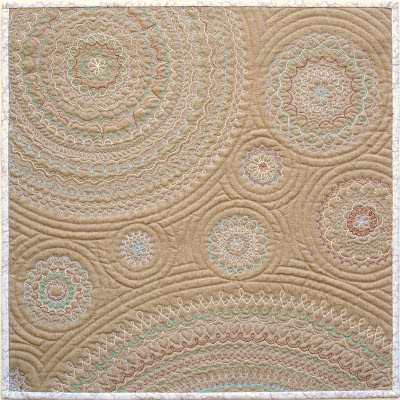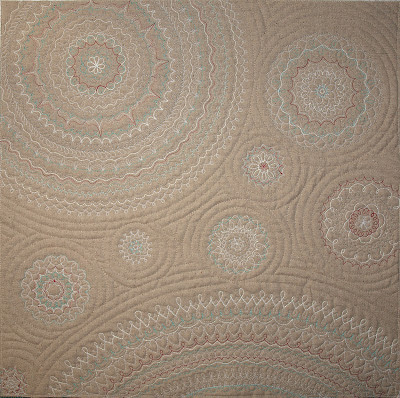I've finally edited the photos of the third customer Swoon quilt I've quilted, ready to share. This one was pieced by
Kayscha. I'm still working out the best set-up for photographing quilts on my foam boards in terms of positioning, keeping the boards vertical and straight, and lighting, but I'm really pleased with this new method. It probably takes longer to pin the quilts in place than it did to tape them up, but this way I can square them much better, whereas I was always distorting them out of square before!
This one was only four, full-size Swoon blocks.
My quilting design incorporated lots of pebbling, both as a filler and in the form of pearls.
While I knew pebbling was time-consuming, I hadn't realised quite how long the strings of pearls would take. This was partly due to the need to repeatedly change the presser-foot pressure, to account for the the bulky seam allowances where multiple pieces converged.
However, I'm really pleased with the effect of the stringls of pearls. I chose to quilt them on a pale aqua thread, to help them stand out, and to match the highlights of aqua in each of the blocks.
I marked the all the curved lines surrounding the pearls using a single template. For the diamonds (below) I also marked the pearls, but free-hand.
I also marked the extra lines inside on some of the sections (below).
While the stippled background works well, it wasn't my first choice. I would have preferred to do more detailed work, but the pebbling had already taken well over the alotted time and I also felt that the detailed work would have been too dense, making the finished quilt too stiff (I know it is to go in a living room) so this was a better choice.
The centre of each block (above) was divided using curved lines into a diamond-in-a-square design, with the resultign spaces filled with pebbling. I also echoed the outer curved lines into the surrounding triangles, and effect I'm very happy with.
The feathers were all quilted free-hand, and it's all done in free-motion (it shows if you look closely at a few of the curves - but I'm getting much smoother!).
All the quilting is done with Glide thread; an off-white for the background stippling, aqua for the pearls and pebbles, and a matching taupe for the feathers.
I'm linking up with Leah's
FMQ Friday.




















































